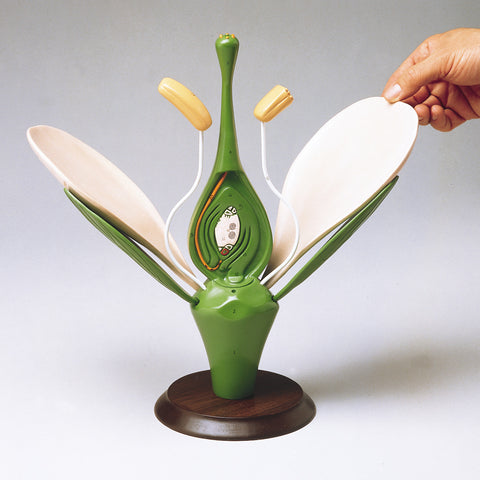0855-00 Bullfrog Junior
U55 Our Junior Bullfrog Won’t Swamp Your Budget!
Scaled-down somewhat from our Great American Bullfrog (Z55), our just-over-life-size adult female Bullfrog Junior embodies the same attention to fine anatomic detail and rugged American-made quality, but is intended to keep your head above water budget-wise.
Life-like sculpting and vibrant hand-painting faithfully portray the same ten organ systems found in its big sister, but with fewer numbered features and no detachable parts.
Molded of non-breakable vinyl plastic, Bullfrog Junior lifts off its hardwood stand for hands-on pass-around study. Hand-numbered features - more than 100 in all - are identified in the accompanying key which also includes a fully-labeled illustration of the reproductive system of a male frog.
classroom questions
- What are adaptations of the frog for securing food?
- Why dont fish have internal nares opening into mouth?
- Watch the breathing movements of a live frog and determine what muscles are used and how they operate taking in and expelling air.
- How do nasal openings act?
- What structures does a frog use in croaking and how do thes structures operate?
- To what bony apparatus is the tongue of the frog attached?
- Trace the following and explain the function of each: systemic circulation, pulmonary circulation, hepatic portal circulation.
- What enzymes act in digestion, where is each produced and how does it act?
- Name the parts of the frog's nervous system and that to man.
- Name the reproductive organs in the frog and explain.
Dorsal Side
-
External naris (singular) nares (plural)
-
Upper eyelid
-
Nictitating Membrane
-
Lower Eyelid
-
Tympanum
-
Sphenethmoid bone (cut)
-
Olfactory nerve (I)
-
Olfactory lobe
-
Cerebrum
-
Diencephalon
-
Optic nerve (II)
-
Optic lobe
-
Cerebellum
-
Fourth ventricle
-
Medulla oblongata
-
Scapula
-
Humerus (cut)
-
Vertebra (singular) vertebrae (plural)
-
Depressor mandibulae muscle (cut)
-
Dorsalis scapulae muscle (cut)
-
Latissimus dorsi muscle (cut)
-
External oblique muscle (cut)
-
Spinal cord
-
Sacral vertebra
-
Ilium
-
Ischium
-
Urostyle
-
Triceps femoris muscle – middle head (tensor
fascia lata muscle) (Vastus externus)
-
Triceps femoris muscle – posterior head
(glutaeus magnus muscle) (rectus femoris)
-
Semimembranosus muscle
-
Ilio bularis muscle
-
Plantaris longus muscle (gastroncnemius
muscle)
-
Peroneus muscle
-
Achilles tendon
Ventral Side
35. Maxillary teeth 36. Palatine ridge 37. Vomerine teeth
Tongue
-
Tongue
-
Trachea
-
Dentary of the mandible
-
Intermandibularis muscle (submaxillary
muscle) (Mylohyoid muscle)
-
Right mandibular vein
-
Larynx
-
Right mandibular vein
-
Right external carotid artery
-
Right systemic arch
-
Right pulmocutaneous arch
-
Right cutaneous artery
-
Right pulmonary artery
-
Right external jugular vein
-
Right brachial vein
-
Right musculocutaneous vein
-
Right pulmonary vein
-
Right innominate vein
Heart External View
-
Right atrium
-
Left atrium
-
Ventricle
-
Truncus arteriosus (conus arteriosus)
-
Right truncus arteriosus
-
Left truncus arteriosus
-
Vena cava
Ventral side
-
Lung
-
Right subclavian artery
-
Right subclavian nerve
-
Oviduct
-
Fat bodies
-
Ovary
-
Liver
-
Gall bladder
-
Cystic duct
-
Bile duct
-
Pancreas
-
Hepatic portal vein
-
Gastric vein
-
Mesenteric vein
-
Splenic vein
-
Dorsal aorta
-
Coeliacomesenteric artery
-
Coeliac artery
-
Stomach
-
Small intestine
-
Spleen
-
Mesenteric artery
-
Right and Left genital vein
-
Right genital artery
-
Right renal vein
-
Right renal artery
-
Kidney
-
Adrenal gland
-
Right renal portal vein
-
Archinephric duct (Ureter)
-
Right common Iliac artery
-
Large intestine
-
Right Sciatic vein
-
Right Iliac vein
-
Urinary bladder
-
Right pelvic vein
-
Right remoral vein
-
Testis (singular) testes (plural)
-
Vasa e erentia
-
Rudimentary oviduct
-
Seminal vesicle
-
Cloaca (Organ, not seen on model, is present in
both male and female frogs.)

We Also Recommend










